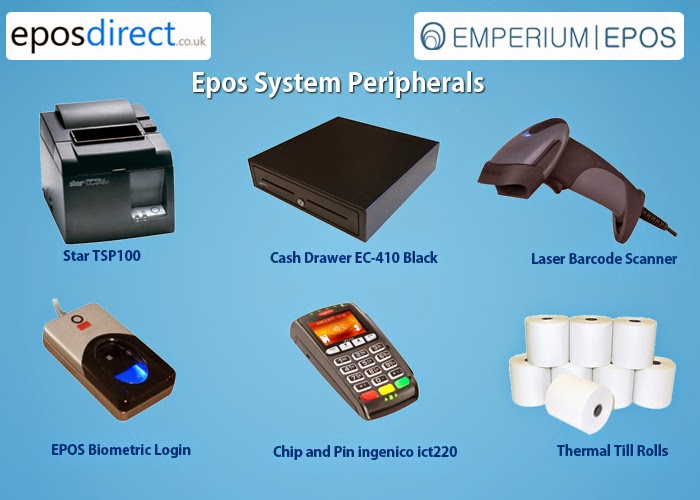An Epos System can be enhanced by a variety of hardware
peripherals ranging from Biometric access devices to Mobile Tablets and
terminals and Payment processing machines. The selection of the appropriate
peripherals to be integrated is dependent on a business’s objectives and
requirements from an Epos system.
Modern Epos systems are designed with the flexibility to
incorporate peripherals as and when a business requires. An obvious advantage
of the peripherals is they provide a quicker, more accurate and orderly
operation. This results in increased
efficiency, reduced wastage and a generally more positive trend bottom line
wise.
 |
| Epos Systems Peripherals and Accessories |
A look at some of the more popular Epos system peripherals
with a brief description is below:
Card payment
processing machines: There were 2.2 billion purchases in the UK totalling a
value of £140 billion (UK Cards Association Plastic Card 2013). This makes card
processing machines an obvious business requirement to maximise sales and
customer satisfaction. About two-thirds of credit card holders have used their
card to make a purchase once or more a month. Businesses that do not have the
option of accepting card payment are narrowing down their customers and
business prospects. Epos systems are now integrable with most modern card payment processing
machines.
Barcode scanners: stock
management and product information retrieval at checkout are two areas where
barcode scanners are prevalent and assist businesses achieve higher efficiency.
Barcode scanners can be static or mobile, single or omnidimensional and come in
different shapes and sizes. Barcode scanners detect barcodes from printed
labels, mobile phones and computer displays.
Cash Drawers: a
range of cash drawers depending on security, size and shape are available in
the market for Epos systems. It provides
security for cash and works with the Epos system during transactions and cash
safeguarding.
Biometric Devices: Epos
systems increasingly control and administer access with Biometric devices. This
allows businesses to control access, administer rights and review and report
any breaches in privileges or security. Biometric devices are seen as being
more accurate and secure in access controls and management.
Tablets and Mobile
Terminals: where businesses require
staff to be on the move, tablets and mobile terminals are increasingly used.
From serving customers on the move to communicating throughout the business
including with the checkout terminals, printers and on the move stock
management are some of the more popular benefits of Tablets and Mobile
Terminals.
Printers: epos systems interact with a variety of
printers. Other than the obvious printing of the transactions and receipt,
printers are also used for printing product information labels and other
communication. Printers come in different sizes and functions.
Weighing Machines:
Epos systems are often connected to electronic weighing scales. This is
especially useful where retailers sell products like vegetables, meat and other
items sold in measurable weight.
Epos Terminals: the
front end of an Epos system, Epos Terminals determines not just the appearance
of an Epos system but also come with many features that distinguish and set the
tone for the Epos system. Touch screen capability, flat screen, size and energy saving functions are some of the common distinguishing features.


.jpg)
.jpg)
.jpg)
.jpg)

.jpg)